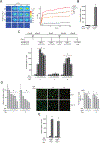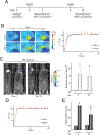Local delivery of bone morphogenetic protein-2 from near infrared-responsive hydrogels for bone tissue regeneration
- PMID: 32135355
- PMCID: PMC7263445
- DOI: 10.1016/j.biomaterials.2020.119909
Local delivery of bone morphogenetic protein-2 from near infrared-responsive hydrogels for bone tissue regeneration
Abstract
Achievement of spatiotemporal control of growth factors production remains a main goal in tissue engineering. In the present work, we combined inducible transgene expression and near infrared (NIR)-responsive hydrogels technologies to develop a therapeutic platform for bone regeneration. A heat-activated and dimerizer-dependent transgene expression system was incorporated into mesenchymal stem cells to conditionally control the production of bone morphogenetic protein 2 (BMP-2). Genetically engineered cells were entrapped in hydrogels based on fibrin and plasmonic gold nanoparticles that transduced incident energy of an NIR laser into heat. In the presence of dimerizer, photoinduced mild hyperthermia induced the release of bioactive BMP-2 from NIR-responsive cell constructs. A critical size bone defect, created in calvaria of immunocompetent mice, was filled with NIR-responsive hydrogels entrapping cells that expressed BMP-2 under the control of the heat-activated and dimerizer-dependent gene circuit. In animals that were treated with dimerizer, NIR irradiation of implants induced BMP-2 production in the bone lesion. Induction of NIR-responsive cell constructs conditionally expressing BMP-2 in bone defects resulted in the formation of new mineralized tissue, thus indicating the therapeutic potential of the technological platform.
Keywords: Bone morphogenetic protein 2; Bone regeneration; Gene therapy; Gold nanoparticles; Hydrogel; Near-infrared.
Copyright © 2020 Elsevier Ltd. All rights reserved.
Conflict of interest statement
Declaration of competing interest The authors declare the following financial interests/personal relationships which may be considered as potential competing interests: The work described herein was partially supported by contracts from HSF Pharmaceuticals S.A. to Nuria Vilaboa.
Figures





Similar articles
-
Pro-angiogenic near infrared-responsive hydrogels for deliberate transgene expression.Acta Biomater. 2018 Sep 15;78:123-136. doi: 10.1016/j.actbio.2018.08.006. Epub 2018 Aug 9. Acta Biomater. 2018. PMID: 30098440
-
Remote Patterning of Transgene Expression Using Near Infrared-Responsive Plasmonic Hydrogels.Methods Mol Biol. 2016;1408:281-92. doi: 10.1007/978-1-4939-3512-3_19. Methods Mol Biol. 2016. PMID: 26965130
-
Gold nanoparticles for the in situ polymerization of near-infrared responsive hydrogels based on fibrin.Acta Biomater. 2019 Dec;100:306-315. doi: 10.1016/j.actbio.2019.09.040. Epub 2019 Sep 27. Acta Biomater. 2019. PMID: 31568875
-
Lipogels responsive to near-infrared light for the triggered release of therapeutic agents.Acta Biomater. 2017 Oct 1;61:54-65. doi: 10.1016/j.actbio.2017.08.010. Epub 2017 Aug 8. Acta Biomater. 2017. PMID: 28801266
-
Recent Advances in Multifunctional Hydrogels for the Treatment of Osteomyelitis.Front Bioeng Biotechnol. 2022 Apr 25;10:865250. doi: 10.3389/fbioe.2022.865250. eCollection 2022. Front Bioeng Biotechnol. 2022. PMID: 35547176 Free PMC article. Review.
Cited by
-
Recent progress in the manipulation of biochemical and biophysical cues for engineering functional tissues.Bioeng Transl Med. 2022 Aug 5;8(2):e10383. doi: 10.1002/btm2.10383. eCollection 2023 Mar. Bioeng Transl Med. 2022. PMID: 36925674 Free PMC article. Review.
-
Metabolic regulation by biomaterials in osteoblast.Front Bioeng Biotechnol. 2023 May 30;11:1184463. doi: 10.3389/fbioe.2023.1184463. eCollection 2023. Front Bioeng Biotechnol. 2023. PMID: 37324445 Free PMC article. Review.
-
Dual release scaffolds as a promising strategy for enhancing bone regeneration: an updated review.Nanomedicine (Lond). 2025 Feb;20(4):371-388. doi: 10.1080/17435889.2025.2457317. Epub 2025 Jan 31. Nanomedicine (Lond). 2025. PMID: 39891431 Review.
-
The Delivery and Activation of Growth Factors Using Nanomaterials for Bone Repair.Pharmaceutics. 2023 Mar 22;15(3):1017. doi: 10.3390/pharmaceutics15031017. Pharmaceutics. 2023. PMID: 36986877 Free PMC article. Review.
-
Effect of inorganic phosphate on migration and osteogenic differentiation of bone marrow mesenchymal stem cells.BMC Dev Biol. 2021 Jan 6;21(1):1. doi: 10.1186/s12861-020-00229-x. BMC Dev Biol. 2021. PMID: 33407089 Free PMC article.
References
-
- Salazar VS, Gamer LW, Rosen V. BMP signalling in skeletal development, disease and repair. Nature reviews Endocrinology. 2016;12:203–21. - PubMed
-
- Pensak M, Hong S, Dukas A, Tinsley B, Drissi H, Tang A, et al. The role of transduced bone marrow cells overexpressing BMP-2 in healing critical-sized defects in a mouse femur. Gene therapy. 2015;22:467–75. - PubMed
-
- Hankenson KD, Gagne K, Shaughnessy M. Extracellular signaling molecules to promote fracture healing and bone regeneration. Advanced drug delivery reviews. 2015;94:3–12. - PubMed
Publication types
MeSH terms
Substances
Grants and funding
LinkOut - more resources
Full Text Sources
Miscellaneous

